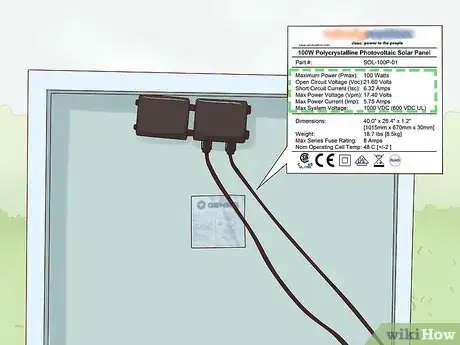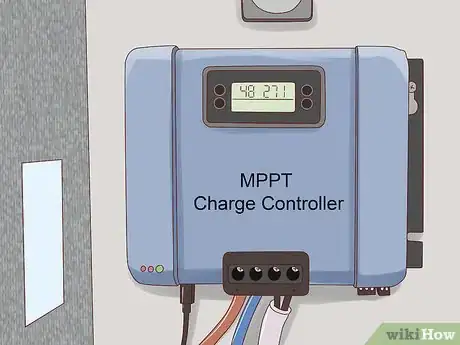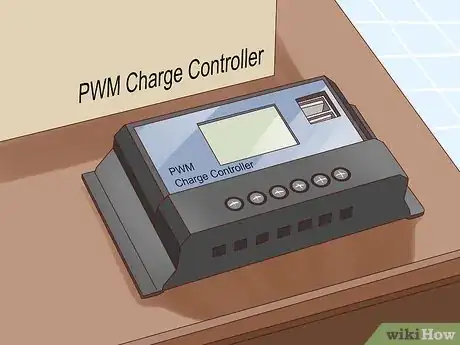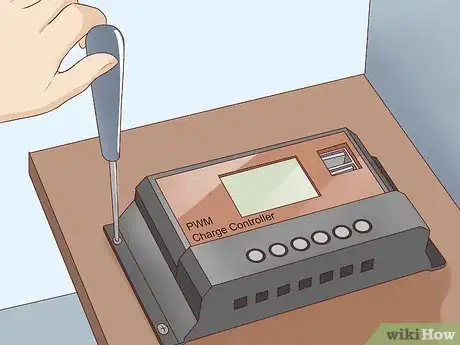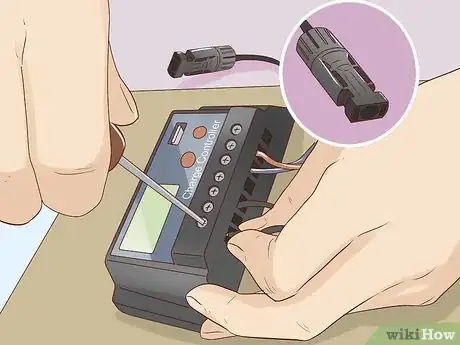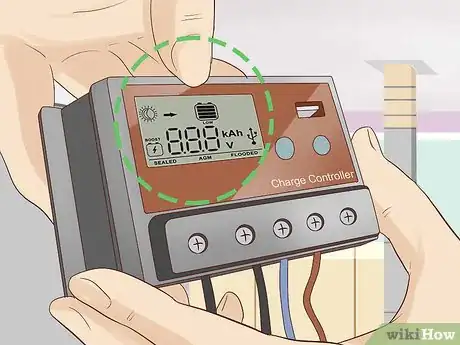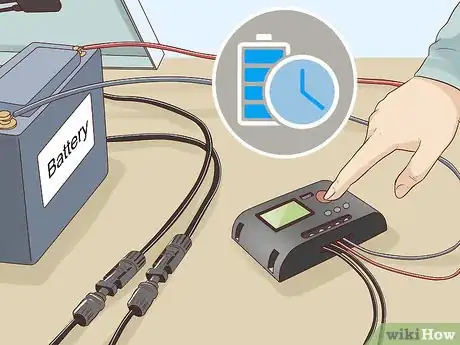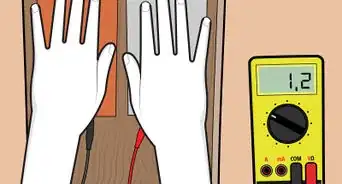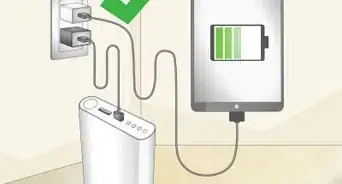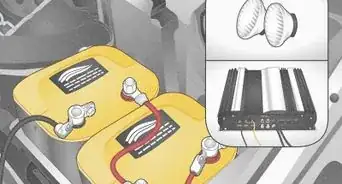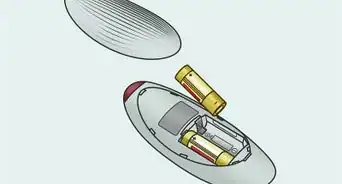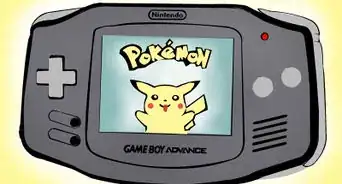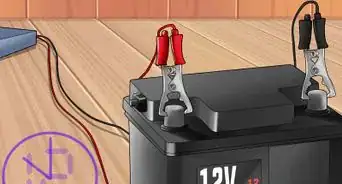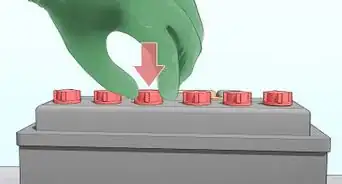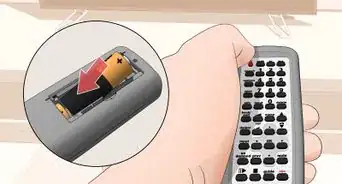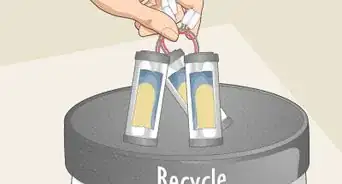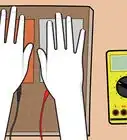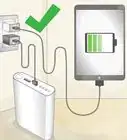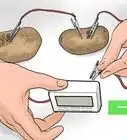This article was co-authored by wikiHow staff writer, Amy Bobinger. Amy Bobinger has been a writer and editor at wikiHow since 2017. She especially enjoys writing articles that help people overcome interpersonal hurdles but frequently covers a variety of subjects, including health and wellness, spirituality, gardening, and more. Amy graduated with a B.A. in English Lit from Mississippi College in 2011 and now lives in her hometown with her husband and two young sons.
There are 10 references cited in this article, which can be found at the bottom of the page.
wikiHow marks an article as reader-approved once it receives enough positive feedback. In this case, 95% of readers who voted found the article helpful, earning it our reader-approved status.
This article has been viewed 100,003 times.
Learn more...
Charging your batteries with a solar panel is a great way to use clean, renewable energy. However, before you can get started, you'll need to install a charge controller, which regulates the voltage from the solar panel as it's transferred to the battery. Otherwise, on sunny days, the solar panel may produce more energy than your battery can handle, which can damage the battery. Luckily, this is an easy process that will have you charging your batteries in no time!
Steps
Purchasing a Charge Controller
-
1Check the back of your panel for the wattage. Typically, there should be a sticker on the back of your solar panel that lists the watts that it will produce. For example, you might see 300W listed on the back of your panel, which means the array produces 300 watts of energy.[1]
- If you don’t have one of those or you built your own solar array, use a multimeter to measure the wattage output of your solar panel when it’s in the full sun.
- Solar panels are designed to produce more power than the voltage they're rated for. For instance, a solar power designed for a 12V output might actually produce 17V of power. That's because they'll only produce their max voltage under ideal conditions.[2]
- If the solar panel produces more power than the battery can handle, the battery can overcharge and be damaged. A charge controller helps prevent this from occurring.
-
2Divide the solar watt rating by the voltage of your battery. You can usually find the voltage listed on the battery itself. Divide this number into the wattage that was listed on the back of your solar panel. This will give you the amps that your charge controller needs to be able to handle in order to safely charge the battery. Often, charge controllers will be rated in multiples of 30 amps, so when you get your number, round up to the next highest rating.[3]
- For example, if your solar panel is 300W and you want to charge a 12V battery, you’d divide 300 by 12 to get 25 amps. In that case, you’d get a charge controller rated for 30 amps.
Advertisement -
3Choose an MPPT charge controller for better efficiency. There are 2 main types of charge controllers: MPPT (Maximum Power Point Tracking) and PWM (Pulse Width Modulation). Both will regulate the maximum voltage that the solar panel can send to the battery, but an MPPT charge controller can be up to 30% more effective at storing and transferring energy than PWM models. Also, you can use MPPT charge controllers with strings of solar panels, but not PWM controllers.[4]
- These options are more expensive than PWM models, but the increased energy efficiency can quickly make up for the price difference.
-
4Purchase a PWM charge controller for a budget-friendly option. If you’re just starting to experiment with solar power, a PWM charge controller can be a good point of entry. These controllers use pulses of energy to charge the battery, and they monitor the power in the battery to ensure it isn’t overcharged.[5]
Tip: The process for installing these controllers is the same, so if you start off with a PWM model and decide you want to upgrade to an MPPT, they’ll be easy to switch out.
Setting up the Controller
-
1Mount the charge controller somewhere grounded and out of the elements. Charge controllers are not weather-proof, so they shouldn’t be installed outside, even if your solar panels are permanently mounted in place. Instead, find an out-of-the-way place to install the charge controller, then run wires from the panel to the controller.[6]
- It's always safest to mount electrical equipment to a non-conductive material, like a PVC panel or a piece of wood, rather than installing it on a metal surface.
-
2Connect a positive and a negative wire to your battery. You can either do this by wrapping bare wires around the battery posts, securing the wires to the posts with clamps, or by using wires with ring connectors that fit over the posts.[7] However, keep in mind that it's safest if you have a way to tell the positive and negative wires apart.
- For instance, you may want to use a red wire as your hot wire and a black one for the negative, or you could use solid black wire for your negative and a black wire with words printed on it for the positive side.
- Of course, if your battery bank already has wires connected, you won’t need to attach new wires to the battery first.
Warning: In order to prevent a sudden surge from damaging the charge controller, it’s best to connect the battery before the solar panel.
-
3Slide the ends of the wires into the input ports on the charge controller. The ends of the wires that plug into the charge controller typically will not need to be fitted with any type of a connector. Instead, slide the ends of the bares positive and negative wires into the corresponding ports, then use a screwdriver to tighten the screws that secure the wires in place.[8]
- Take care to match up the positive and negative cables with the appropriate ports, or you could short out your battery or controller.
- If you're connecting a 12V battery, use 10-gauge or 16-gauge wire.[9]
-
4Use MC4 connectors to connect the wires to the charge controller. The output wires on solar panels are typically fitted with MC4 connectors, which are long cylindrical fittings that have a male and a female side.[10] In order to ensure they connect correctly, fit the wires running from your charge connector with MC4 connectors. Attach the bare ends of the input wires to the charge connector the same way that you attached the output wires—slide them into the input ports and tighten the screws with a screwdriver.
- You can find these connectors wherever electrical or solar supplies are sold, and they should come with specific instructions on how to attach them to the wires.
-
5Connect the wires from the controller to the solar panel. Once you've attached the input wires to the charge connector, you should have 2 loose wires, each ending in an MC4 connector. Match up the male and female connectors with the opposite ones coming away from the solar panel, and snap the MC4 connectors into place. You should hear a “click” when the connectors are seated securely.[11]
- Be sure to connect the male connector to a female connector and vice versa.
- You can never be too careful when you’re working with electricity. Take the time to double-check that the positive and negative cables are matched up correctly!
-
6Check the output on the charge connector to make sure it’s working. Most charge connectors have a digital screen that will show you the output that’s flowing to the battery. If the readings are 0, double-check that everything is hooked up correctly.[12]
- Some charge connectors will even communicate with an app, so you can monitor the voltage from your smartphone or tablet!
-
7Leave the battery on the connector until it’s charged. The length of time it will take to charge your battery will depend on the size of the battery you’re using, the wattage of the solar panel, and even the weather that day. That’s where your digital display will come in handy. When you notice the output dropping, it’s likely that the battery is close to fully charged.[13]
- Since the charge connector will stop the flow of energy to the battery once it’s charged, it’s fine to leave it on the charger until you need it!
Community Q&A
-
QuestionHow do I measure the amperes in my battery so I will know the wattage of my 12 volt battery?
 RobertCommunity AnswerThe easiest way to measure amperage is through the use of a digital multimeter. Make sure it is set to read amperage, you can then use a clamp on meter around the "hot" leg and record the actual amperage. If you do not have access to a ammeter clamp, you can open the circuit and insert the probes in series with the circuit. This will allow all electrons to pass through the meter and give you an accurate reading. Once you know your amperage, use the formula: Wattage = amperage x voltage.
RobertCommunity AnswerThe easiest way to measure amperage is through the use of a digital multimeter. Make sure it is set to read amperage, you can then use a clamp on meter around the "hot" leg and record the actual amperage. If you do not have access to a ammeter clamp, you can open the circuit and insert the probes in series with the circuit. This will allow all electrons to pass through the meter and give you an accurate reading. Once you know your amperage, use the formula: Wattage = amperage x voltage. -
QuestionHow can I connect a solar panel charger to more than one battery?
 Phillip KingCommunity AnswerA parallel connection avoids any change in the voltage level and is simple. Position your batteries side by side and run a separate pair of wires from the panel to each battery, connecting negative (-) to (-) and positive (+) to (+).
Phillip KingCommunity AnswerA parallel connection avoids any change in the voltage level and is simple. Position your batteries side by side and run a separate pair of wires from the panel to each battery, connecting negative (-) to (-) and positive (+) to (+).
Warnings
- Be sure to properly identify and mark the positive and negative wires so you can tell them apart and connect them correctly.⧼thumbs_response⧽
- Connect the battery to the charge controller before connecting the solar panels to the charge controller.⧼thumbs_response⧽
Things You'll Need
- Solar panel
- Battery
- Charge controller
- 16-gauge wire
- 2 MC4 connectors
- Screwdriver
- Multimeter
References
- ↑ https://www.solaronline.com.au/solar_system_basics.html
- ↑ https://youtu.be/sU-hSFFwSmo?t=452
- ↑ https://www.solarpowerworldonline.com/2014/09/how-to-choose-the-perfect-charge-controller/
- ↑ https://youtu.be/sU-hSFFwSmo?t=452
- ↑ https://youtu.be/sU-hSFFwSmo?t=452
- ↑ https://www.morningstarcorp.com/faq/how-does-solar-charge-controller-work/
- ↑ https://www.ecoideaz.com/expert-corner/step-by-step-guide-on-how-to-set-up-solar-power-at-home
- ↑ https://youtu.be/e-TcHo_x-rc?t=15
- ↑ https://www.thespruce.com/matching-wire-size-to-circuit-amperage-1152865
About This Article
To charge a battery with a solar panel, connect a charge connector to the solar panel. Divide the wattage of the solar panel by the voltage of the battery to get the number of amps your charge connector needs to handle. Then, run wires from the battery to the charge connector, making sure to match the positive and negative poles. Finally, attach the charge connector to the solar panel with wires fitted with MC4 connectors, since the output wires on most solar panels use these connectors. To learn how to choose the best charge connector for your solar array, read on!
